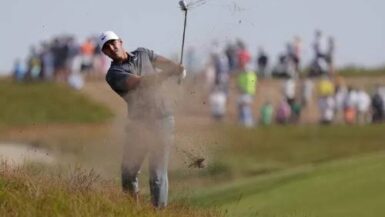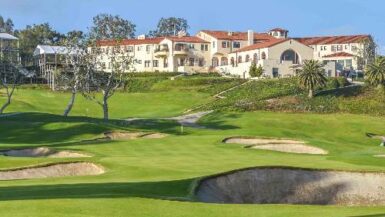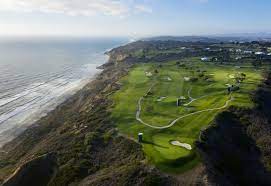
Phil Mickelson picked out a few on the front nine and golf architect Rees Jones focused on 11-13, but perhaps the best aspect of Torrey Pines’ South is its wondrous variety. A mix of short holes and long holes, together with movable teeing grounds and hazards more closely menacing fairways and greens, Torrey Pines should generate wild swings on the leaderboard and plenty of excitement. Let’s take a closer look at where we might see the most action on the South Course.
2nd Hole, 347 yards, par-4.
“Wait a minute!” you exclaim. “What about the first hole?! Tiger made three double bogeys there when he won in 2008!” Yes, you’re right, he did. But he also made that ordinary hole much harder than it had to be. By the way, Tiger actually made four double bogeys in the Open that year, the most ever carded by a winner since 1929 when Bobby Jones won at Winged Foot West despite posting five doubles and a triple. Jones’s winning score? 7-over. (He defeated Al Espinosa by 23 shots in the 36-hole playoff.) Woods, who also won in a playoff finished the ’08 Open with a 1-under 283. How times change.
No, the second hole is one to watch as a possible birdie or even eagle hole, as it could be drivable by the longest hitters. (Remember Collin Morakawa at Harding Park last year?) The heart-shaped green is, typical of Rees Jones restoration work here, three little greens in one. It fits here well since the hole is so short by modern professional standards.
3rd Hole, par-3, 150, 190 yards
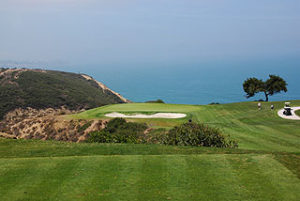
Take the green from the last hole and turn it on its side, and that’s the third green. Left pin positions are the most dangerous as they bring the canyon into play and penalty strokes. They moved the tee box around in 2008 so that it could play either 148 yards or 188. The longer yardage is expected to play to right side pins, while the shorter tee box should herald a left side hole location. Despite its diminutive length, it still ranked 11 out of 18th in difficulty in 2008.
4th Hole, par-4, 446, 486 yards
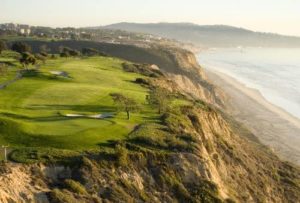
Another movable teeing ground greets the players at opne of the more difficult driving holes on the South Course. Both fairway and green are positioned closer to the canyon’s edge, and the fairway slopes dangerously to the left, making the tee shot more difficult stil. Once again three tiny greens in one form the putting surface, but this time it’s a fairway wood or hybrid most players will have into the green, far harder to stop without risking going over the green and into the canyon.
“There’s a lot of holes where it kind of turns or tightens, and I don’t really want to get to that spot. If you look at 4, you get it down too far and it starts to pinch in by the canyon,” Phil Mickelson confirmed in his pre-tournament interview. “The fairways will be a lot firmer than at the Farmers.” And that means three and four are great places for spectators as they’ll see plenty of action.
6th Hole, par-4, 515 yards
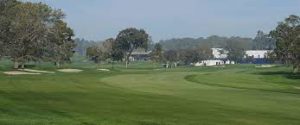
Converted from a par-5 to a par-4 for the championship, and weighing in at a hefty 515, yards, the hole bends sharply left, but features bunkers outside the knee of the dogleg instead of strategically guarding the inside. The longest hitters will invert the conventional game plan and just try to blast driver with a soft draw over an edge of the canyon.
Also, Rees frequently pushes up his green sites, such as here, hence a low runner might not reach, or worse might end up in either the five o’clock bunker or seven o’clock bunker. In 2008 this was the second hardest hole on the golf course, behind only the 12th.
10th Hole, par-4, 449 yards
This hole was lengthened 35 yards by Jones during the 2019 touch up work he supervised. It needed it: the tenth was the fifth easiest hole during the 2008 Open.
The last birdie op before the finish is straightforward – hit the fairway, wedge to the right segment of the green, roll in the putt, and head to Torrey Pines’ Amen Corner at 11, 12, and 13.
11th Hole, par-4, 222 yards
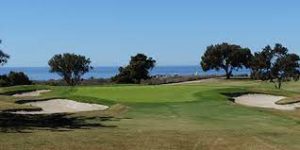
The most difficult of the par-3s at Torrey Pines plays significantly longer because it’s an uphill shot to a narrow green with the prevailing wind coming across fromt the player’s right and against him as well.
It played the fifth hardest hole on the golf course in 2008.
13th Hole, par-5, 612 yards
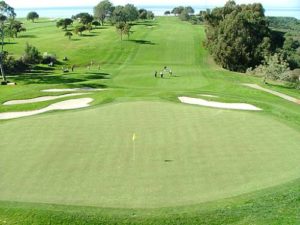
Ever the tinkerer, in 2008, Phil Mickelson left his driver at home and inserted a fifth wedge. After two days of indifferent play, the driver was back in the bag, and one of the five wedges was gone.
Guess which one Phil likely needed facing the severe false front of the 13th green? The one that might have saved him for taking three walks of shame and a ghastly nine? That’s not the way to play the second easiest hole on the golf course.
17th Hole, par-4, 441 yards
Now for the epic finish. At just 441 yards, it’s just a short iron for the players to a small, circular green. The biggest trouble may be the rough, and if you see someone in the right fairway bunker, that was likely a mistake.
18th Hole, par-5, 572 yards

Who can forget the magic Tiger Woods wrought on this green three consecutive days? A 66-foot bomb for eagle, followed by back-to-back tournament extending putts.
For those of you who like local lore, the pond fronting the green is called “Devlin’s Billabong,” after old west coast Tour star Bruce Devlin. On one occasion, the tried to heroically get into a playoff by playing a ball out of the water, but instead took six swings and fell off the leaderboard with a resounding thud. That’s not the way to get a golf hole named after you.
In 2008, it played the easiest hole on the golf course. Expect the same this year, especially with modern equipment bringing eagle into play more than ever before.


